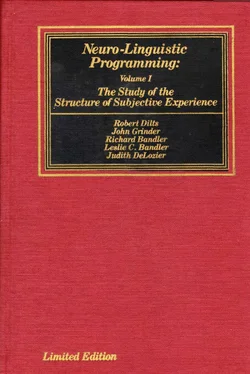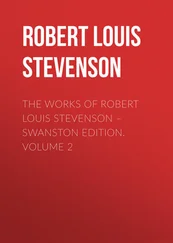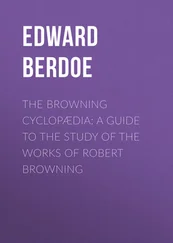The author began by first eliciting a resource strategy — specifically, the strategy that she used to work with her clients. It was a fine strategy for therapeutic work which included two basic subroutines. When a client would come in the therapist would first carefully observe him visually and auditorily (V e+A e). As she observed, she would begin to pace him posturally, gesturally, and with her breathing (K e). As she did so, she would begin to get internal feelings about the client and would have the experience of somehow stepping into the client's body (K i). If the feelings she got from this were too negative or too intense, she would access an operation that involved a dissociation from her feelings by refocusing her attention completely on external visual and auditory experience (V c→A e). She would then ask herself or talk to herself about what could be done with this client (A i d) and begin to remember images of what she had done with previous clients (V r ).When the image reached a certain degree of clarity she would implement physically with the client (K e) what she had seen. She would then test the result of her actions through her external sensory channels and repeat the process of pacing as a test to find if the intense kinesthetic feelings had begun to subside. If they hadn't she would repeat this subroutine. If the feelings had lessened enough she would begin a second operation which involved a continued pacing of the client's posture, gestures and breathing (K e) and would start to operate on the feelings she got from them (K 1). These feelings would access constructed images of possible interventions she could make (V c) which she would immediately implement (K e). She would then return again to the beginning of the strategy and test the results of her intervention by observing the client's response through her external sensory channels. In her estimation, this operation was much more creative than the other. Represented in its entirety, we could show this strategy as:

The author noted that as the therapist discussed this strategy her posture was erect and her shoulders were thrown back. Her head was tilted slightly upward and she breathed evenly from her chest.
The strategy in operation during her phobic response was a simple but powerful V i -→K isynesthesia. The external triggers would access a rapid internal visual image which would immediately anchor a strong kinesthetic reaction. In this state the posture of the therapist was slumped forward, head to her knees, eyes closed and watery with her hands covering her face. The elicitation procedures uncovered that the image was one of herself as a child, where she had been consistently and severely mistreated and beaten by her parents.
The following is a transcript of how the author ("A") utilized the therapist's ("T") resource strategy to help her overcome the phobic response. The transcript begins after the author has re–elicited the phobic response so that he may work with it. He has previously established a resource anchor with the therapist (self–initiated) in which the tighter she squeezes his wrist the more she can access a particularly positive reference experience.
TRANSCRIPT
(T is leaning forward with her head on her knees — A interrupts the ongoing strategy by having her change posture and other accessing cues.)
A: Now if you want to get over this thing it will be important that you follow all of my instructions … I want you to sit up straight … okay? … (helps T into upright position) … now open your eyes and look at me until you can see me clearly … come outside so that you are no longer hooked into all of that internal stuff … look at me.
T: (Sobbing slightly) I'm trying … (starts to slump over again).
A: Stay sitting up straight (holds her in upright position) … Squeeze my wrist.
T: I'm trying to … it's hard . .. my body keeps wanting to go back down there …
A: I know, but it's important that you stay up straight … now I want you to breath up here in your chest … Just concentrate on that for a while.
T :(Begins to breathe regularly and finally gets control over her posture.)
A: That's right … keep squeezing my wrist … Does it help?
T: Uh-huh. (Sobbing has stopped.)
A: Okay, now tilt your head back … and I want you to look up there for a minute and see, and I only want you to see it, … see that image that you see right before you get that reaction.
T: (Begins to close eyes, wrinkle face and slump over.)
A: Squeeze my wrist now … open your eyes and look up there… Do you see it?
T: (Voice beginning to break) Yes …
A: Now I want you to look at that image carefully … and I want you to imagine that this little girl has just come into your office … Can you still see her?
T: (Tonality steadying, posture becoming more upright) Yes.
A: Can you hear her voice?
T: (Beginning to close her eyes and cry) … She's calling for help.
A: Now keep your eyes open and look up there at her … keep breathing … (wiggles his wrist until T begins to squeeze it) … Now I want you to imagine putting your body into her position and to feel her feelings … (K e→K i)
T: Ohhh … (Closes her eyes and slumps over).
A: Okay, that's enough, come back here with me … Sit up … Open your eyes and look at me … Squeeze my wrist … (Waits until T has recovered — then begins to utilize T's operation involving dissociation from the client)… . Now this time I want you to just look at the child and listen to the tonal qualities of her voice … Continue squeezing my wrist as much as you need to … As you continue to look at her I want you to ask yourself (A i d) what you could do to help her … Can you see (V i) anything to do to help her?
T: What I can do? (Holding back tears.)
A: Yes … What can you do to help her … What would you do if she were a client of yours? (Directs T's eyes up and left.)
T: (Looking down and left, then up and left) … Well … (long pause) I could go over and hold her.
A: Okay, good … I want you to imagine the body sensations of going over and taking that child in your arms and holding her … (K e) Can you do that?
T: (Eyes shift down and right, face flattens) … Uh-huh …
A: Now look at the child … (V e) How is she responding? T: (Voice hesitant as if somewhat surprised) … She feels better
A: Is she saying anything? (A e)
T: Umm … No … She wants to be inside herself… so she can heal.
A: If you were to mirror her body posture now, would you be willing to take on her feelings … (K e'K')
T: (Stares down and right, defocuses) … No … She still has so much pain … (Begins to cry again and slump forward.)
A: Sit back up … (helps her into upright position) … Look at me … that's right … Squeeze my wrist … Come back … and just look at the girl again … (V e) and ask yourself what else you can do … (A i d) (T's eye move down and to the left) … That's right… Now can you see anything else that you can do to help this child? (V i)
T: (Eyes flick up and left) I can reassure her … and tell her to breath … she isn't breathing very much … and I can just hold her … that's what she says that she wants the most … and I can tell her that it's okay to look at me
A: Fine … Now imagine the feelings of what it would be like if you were actually doing that … (K e)
T: (Eye position changes a number of times and eventually ends up down and right) Uh-huh … Okay …
A: Look at the child … how does she respond? (V e)
Читать дальше












